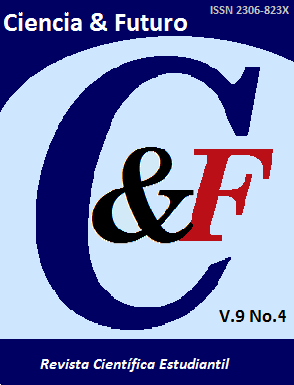Magnetic domains in heat treated and welded AISI 4340 steel with coated electrodes
Keywords:
Magnetic noise, microstructures, electrodes, envelopes, austenite-ferriteAbstract
The behavior of AISI 4340 steel was established after being subjected to welding process with electrode E 7018 of four millimeters in diameter, electrode E 312–16 and UTP 65 with a diameter of 3,2 mm, respectively. Samples with dimensions of 100 x 50 mm were prepared which, after the thermal welding cycle, were subjected to a non-destructive test (END) such as Barkhausen Magnetic Noise. The microstructural analysis revealed that welding AISI 4340 steel with electrodes of type E 7018 promotes the formation of the sigma phase from the ferrite and introduces a hardness of 498,70 HV causing a fragile bead, with the deposit with the UTP electrode 65 favorable changes in the Barkhausen signals, the ferrite-austenite microstructures and hardness of 315 HV are shown demonstrate the feasibility in welding with the latter.Downloads
References
GARCÍA, Y.; BURGOS, J.; GIL, F. & RIVALTA, J. 2006. Obtención de tensiones residuales a lo largo de un cordón de soldadura mediante métodos analíticos y experimentales. Soldagem Insp 11(2): 4-9.
JILES, D. 2000. Dynamics of domain magnetization and the Barkhausen effect. Czechoslovak Journal of Physics 50(8): 893-988.
LACHMANN, C.; NITSCHKE, T. & WOHLFAHRT, H. 2000. Characterisation of residual stress Relaxation in Fatigue Loaded Welded Joints by X-Ray Diffraction and Barkhausen Noise Method. Materials Science Forum 347(349): 374-379.
MARTÍNEZ, P.; ESPINA, J.; HALLEN, J.; LINARES, R. & MIRANDA, Y. 2010. Caracterización de Aceros API-5L por Medio de la Medición de Ruido Magnético Barkhausen. Revista Científica 14(2): 81-87.
MOORTHY; V.; SHAW, B. & EVANS, J. 2003. Evaluation of tempering induced changes in the hardness profile of case-carburised EN steel using magnetic Barkhausen noise analysis. NDT&E International 36(12): 43-49.
NOLAN, D.; STERJOVSKI, Z. & DUNNE, D. 2005. Hardness prediction models based on HAZ simulation for in – service welded pipeline steels. Science and Technology of Welding and Joining 6(10): 681–694.
NORMA ASTM E 3-95. 2017. Standard Practice for Preparation of Metallographic Specimens.
NORMA CUBANA NC 10-56. 1986. Metalografía. Microestructura de Metales de aleaciones duras. Métodos de ensayo.
PARK, D. G.; KIM, C. G. & HONG, J. H. 2000. Microestructural dependence of Barkhausen noise and magnetic relaxation in the weld HAZ of and RPV steel. Journal of Magnetism and Magnetic Materials 215(216): 765-768.
PÉREZ, J.; CAPÓ, J.; ANGLADA, Y. & PADOVESE, L. 2005. A model for the influence of microstructural defects on magnetic Barkhausen noise in plain steels. J. Magn. Magn. Mater. 288: 433-442.
PRASAD, K. & DWIVEDI, D. 2008. Some investigation on microstructure and mechanical properties of submerged arc welded HSLA steel joints. International Journal of advance manufacturing technology 36(6): 475-483.
PRICE, J. W.; ZIARA-PARADOWSKA, A.; JOSHI, S.; FINLAYSON, T.; SEMETAY, C. & NIED, H. 2008. Comparison of experimental and theoretical residual stresses in welds: The issue of gauge volume. International Journal of Mechanical Sciences 50(3): 513-521.
PUPO, C. & PÉREZ, J. 2009. Influencia del tamaño de grano en el ruido magnético de Barkhausen en los aceros AISI/SAE 1005-1070. Revista Cubana Física 26(2B): 251-256.
QUINTERO, M.; CERPA, S.; MEJIAS, G.; LEÓN, J. & QUINTERO, A. 2006. Soldadura de un acero inoxidable dúplex 2205 por el proceso de soldadura
GTAW. Revista Latinoamericana de Metalurgia y Materiales 56(4): 1-3.
RUIZ, D.; PIOTRKOWSKI, R.; LÓPEZ, M. & RUZZANTE, J. 2008. Ruido Barkhausen y emisión magneto acústica para la caracterización de materiales ferromagnéticos. Matéria 13(1): 31-45.
SEOK, J. 2008. Characterization of bainitic microstructures in low carbon HSLA steels. International Journal of Moder Phisics B 22(31): 5965-5970.
Published
How to Cite
Issue
Section
Copyright (c) 2019 Anival Nicot-Hinojosa, Tomás Fernández-Columbié, Rafael Castillo-Díaz, Cayetano Durán-Abella

This work is licensed under a Creative Commons Attribution-NonCommercial 4.0 International License.
Esta obra está bajo una Licencia Creative Commons Reconocimiento-NoComercial 4.0 Internacional
La Revista Ciencia & Futuro es una revista de acceso abierto, todo el contenido está disponible gratuitamente sin cargo para el usuario o su institución. Los usuarios pueden leer, descargar, copiar, distribuir, imprimir, buscar o vincular los textos completos de los artículos, o utilizarlos para cualquier otro fin lícito, sin pedir permiso previo al editor o al autor. Todo lo anterior, de acuerdo con la definición de BOAI de acceso abierto.
Los autores que publican en esta revista están de acuerdo con los siguientes términos: Licencia Creative Commons Atribución-NoComercial permite que el beneficiario de la licencia tenga el derecho de copiar, distribuir, exhibir y representar la obra y hacer obras derivadas para fines no comerciales siempre y cuando reconozca y cite la obra de la forma especificada por el autor o el licenciante. Los autores pueden establecer por separado acuerdos adicionales para la distribución no exclusiva de la versión de la obra publicada en la revista (por ejemplo, situarlo en un repositorio institucional o publicarlo en un libro), con un reconocimiento de su publicación inicial en esta revista. Se permite y se anima a los autores a difundir sus trabajos electrónicamente (por ejemplo, en repositorios institucionales o en su propio sitio web) antes y durante el proceso de envío, ya que puede dar lugar a intercambios productivos, así como a una citación más temprana y mayor de los trabajos publicados (Véase The Effect of Open Access) (en inglés). Lo anterior debe realizarse siempre sobre el artículo ya publicado por Ciencia & Futuro.
Los autores mantienen el control sobre la integridad de sus trabajos y el derecho a ser adecuadamente reconocidos y citados.
A los editores se les otorgan derechos no exclusivos para publicar y distribuir.







